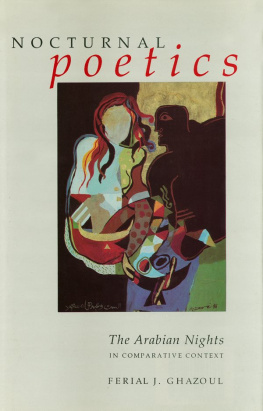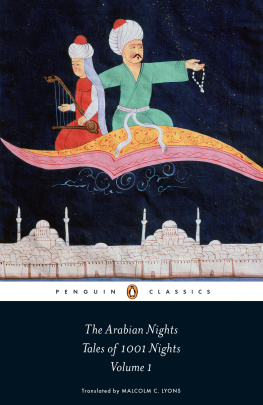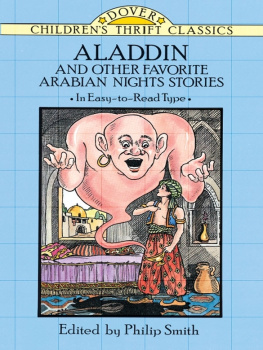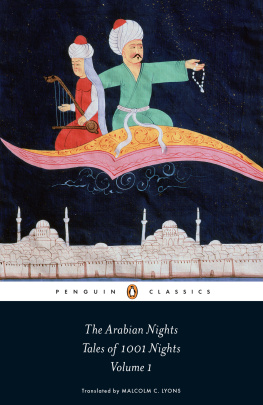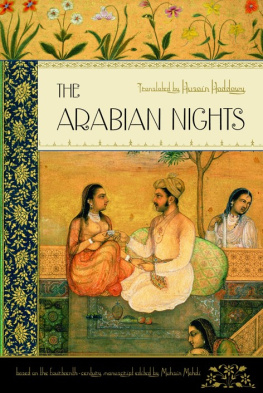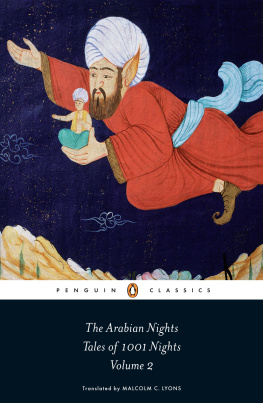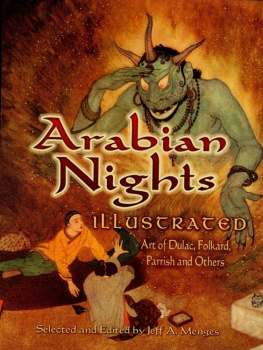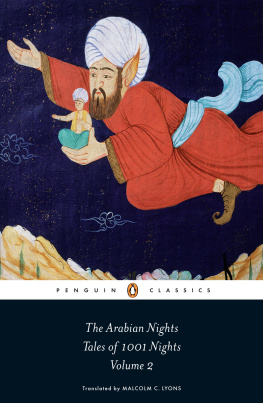N OCTURNAL P OETICS
N OCTURNAL P OETICS
The Arabian Nights in Comparative Context
Ferial J. Ghazoul
T HE A MERICAN U NIVERSITY IN C AIRO P RESS
C AIRO N EW Y ORK
Copyright 1996, 2014 by
The American University in Cairo Press
113 Sharia Kasr el Aini, Cairo, Egypt
420 Fifth Avenue, New York, NY 10018
www.aucpress.com
First published in hardback in 1996 by the American University in Cairo Press
All rights reserved. No part of this publication may be reproduced, stored in a retrieval system, or transmitted in any form or by any means, electronic, mechanical, photocopying, recording, or otherwise, without the prior written permission of the publisher.
ISBN 978 977 424 363 9
eISBN 978 161 797 538 7
Version 1
C ONTENTS
Part I
Part II
The Arabian Nights has captivated me ever since I can remember and has been a constant companion for me until today. This book has been shaped by intimate coexistence with the text as much as by studies, readings, and research undertaken over two decades during which The Arabian Nights was a focal point of reference and an aesthetic consolation. My professors at Columbia University, who supervised my studies and dissertation in the seventies, Michael Riffaterre, Edward W. Said, and Tzvetan Todorovas well as Muhsin Mahdi of Harvard University, whose seminars on literature and philosophy I attendedhave had a profound impact on me. I am also indebted to numerous colleagues at the American University in Cairo, where I have been teaching for the last seventeen years, as well as to friends in the Egyptian state universities with whom I have carried on a dialogue on literature. I would also like to acknowledge my students, who have with their probing questions and indicative reactionshelped shape this study.
I have been writing this book for years, in an ongoing attempt to understand the internal structure of The Arabian Nights, its relationship to world literature, its significance, and its sphere of influence and correspondence. Part One of this book (the first eight chapters) is an update of my out-of- print book The Arabian Nights: A Structural Analysis, published in Cairo in 1980 by the National Commission of UNESCO as part of a series of awarded studies which present and illuminate Arab cultural values. This part of the book addresses the symbolic logic and inner meaning of The Arabian Nights, exploring the relationship between the frame story and the enframed stories and the patterns of generating stories. Having pinned down the articulations of the work, its sense and significance are then highlighted. Part Two ().
I am grateful to the staff of the American University in Cairo Press for the production of this book, particularly the close reading of Simon ORourke and the general supervision of Neil Hewison. The support of my family has been invaluable in completing this project.
This study is undertaken within the framework of comparative literature. Its objective is to uncover principles of construction of the literary work commonly known as The Arabian Nights, sometimes referred to as The One Thousand and One Nightsthe literal translation of its Arabic title. Although it originated in the East and was given its finished and present form by the Arabs, the work has come to be part of the literary tradition of the West, if not the entire world.
The point of departure is the study of a concrete literary work whose foundations can illuminate the elusive phenomenon we call literature. Traditional literary studies apply literary canons and criteria to a text and end invariably by passing a value judgment on the quality of the work. In this case, however, the quality of The Arabian Nights as a literary text is taken for grantedthis study strives to extract the structural principles underlying the text. The work is analyzed and its articulations revealed in order to comprehend what Roman Jakobson has called literaturnost, that quality which makes a given discourse literary. After outlining the specificity of the work and revealing its inner system, I explore its relations and correspondences with literary works from other traditions.
In this context, therefore, the literary work is not treated as the final object of the inquiry, but as particular case displaying certain processes that can be encountered in other texts and in other systems of communication. It is precisely those operations at work in a literary text that are the object of this study: operations that combine the artistic and linguistic faculties.
This approach is analytical and strives to provide a systematic presentation of a literary text based on investigation rather than speculative reasoning. My work aspires to be a step in the direction of methodological examination of the literary phenomenon. It tries to look into unfamiliar literary structures as part of the human literary production and not as deviations from given norms. Hence the importance of seeing The Arabian Nights as a viable literary form, within its proper cultural, traditional, and rhetorical background, before comparing it to primary literary texts from other cultures and traditions.
The focus on models in this study is a direct outcome of its analytical intention. The meta-languagethe terminology used to describe the text is drawn from grammar and rhetoric, on the grounds that literature is a specific instance of language use and poetic production. I have deliberately avoided technical terminology associated with specific literary schools and have tried to use the most accepted and accessible terms. My reason for doing this is that I have undertaken this work in order to understand a given text, not to support a polemical critical position. With the same attitude, I have restricted the use of diacritical marks in my transliteration of Arabic and Persian words; Turkish words are given in their modern Turkish orthography. I transliterate according to the written form of the word, independent of the pronunciation, using the English transliteration system as adopted by the International Journal of Middle East Studies.
(Textual Variants and Critical Methodology) introduces the text of The Arabian Nights as a phenomenon with its own peculiarity and specificity, and then expounds the methodology underlying the study.
(Narrative Dialectics) sums up the fundamental forces and elements at work in The Arabian Nights, elaborating their interconnections and the formation of a system. This chapter thus deals with the organization of the text.
(Discursive Significance) analyzes the narrative by condensing it to its matrix or essential identity, and shows its diffusion in the text through codes. This chapter describes the basic movement of the text.
(Perpetual Narrative) concludes Part One. Here, the study of the intrinsic structure is brought into final focus and its intelligibility is spelled out in terms of alternatives to Aristotelian poetics.
In Part Two, (Nomadic Text) concludes the book and outlines the aesthetic lessons of its migration and literary acculturation.
It should be perhaps pointed out that Part One is divided into two distinct and complementary sections. , which constitute the first section, are devoted to the main narrative course in The Arabian Nights and deal essentially with the frame story. Following an order of increasing complexity, the first chapter starts with The Arabian Nights as a given artistic presence, the second chapter delineates the combination of its literary components, and the third chapter explores its semantic significance. Each step leads to the next and is indispensable for the development of the argument.

